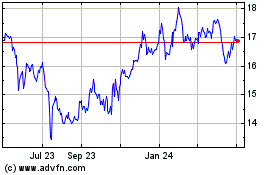Why AT&T Wants to Build a Wireless Network for the Police --Update
March 30 2017 - 2:24PM
Dow Jones News
By Ryan Knutson
For first responders and law enforcement, the benefits of the
dedicated nationwide network announced on Thursday are obvious.
The network, to be called FirstNet, will prioritize data traffic
from police officers, firefighters and other emergency responders,
so they won't be subject to the same network congestion consumers
face. That is crucial in a disaster, when citizens often rush to
their phones all at once. The network will also operate in very
rural areas and across jurisdictions, so that if police from a
neighboring town arrive to help, their devices will still work.
But what's in it for AT&T Inc., which won the 25-year
contract to build FirstNet?
The second-largest U.S. wireless carrier by subscribers gets two
things: a large swath of wireless airwaves, known as spectrum; and
$6.5 billion over five years for construction. AT&T will be
allowed to use the 20 megahertz of spectrum in its commercial
network, which is about 13% of its current holdings. That means
AT&T wireless consumers will receive faster connections thanks
to the extra capacity, which AT&T hopes will entice new
customers.
AT&T says it will spend $40 billion over the 25-year
contract to build and maintain the network, which it says will
create 10,000 jobs. It expects to generate revenue by selling
subscriptions to public safety agencies and selling the extra
capacity to commercial customers.
While AT&T won the national contract, it now must compete at
the state level. Each state has the ability to opt out of
AT&T's network and instead build one of its own, which it may
want to do if it believes it can develop a better network with
another provider, offering, for example, more rural coverage. If a
state opts out, AT&T would lose access to the airwaves in that
state.
AT&T finance chief John Stephens said the dollars spent on
infrastructure will depend on how many states take up the offer.
The company's previous financial forecasts for 2017 didn't include
this project.
"We'll add new radios, new antennas, we'll add new towers and
distribution. We'll add to our network for backhaul," Mr. Stephens
said in an interview, adding the new network will also "leverage
off these 50,000-plus towers we already have in service."
AT&T and FirstNet tailored proposals for 56 states and
territories that by law must decide whether to join the network 90
days after receiving the pitch. Mr. Stephens said the company will
know where each state stands by the end of this year.
"AT&T has made itself ready to start making investments and
generating jobs," Mr. Stephens said. "The sooner the better. We'll
be very aggressive to look for any opportunities to get the draft
plans into the states' hands as soon as possible."
A startup called Rivada Mercury LLC says it will try to pick off
some states. Five of them, Colorado, New Hampshire, Alabama,
Arizona and Michigan, have issued requests for proposals to explore
their options.
Rivada's business model is to use the 20 megahertz to build a
brand new network and resell the capacity to wireless carriers or
any other company that wants connectivity, such as a trucking firm
that wants to track its rigs, for instance.
Because populous areas subsidize more rural ones, experts worry
that the entire project could be harmed if too many large states
opt out. Another risk would be public safety agencies not switching
from their existing wireless carriers to FirstNet.
Write to Ryan Knutson at ryan.knutson@wsj.com
(END) Dow Jones Newswires
March 30, 2017 14:09 ET (18:09 GMT)
Copyright (c) 2017 Dow Jones & Company, Inc.
AT&T (NYSE:T)
Historical Stock Chart
From Mar 2024 to Apr 2024

AT&T (NYSE:T)
Historical Stock Chart
From Apr 2023 to Apr 2024
